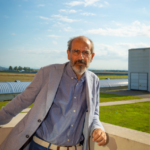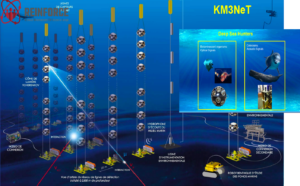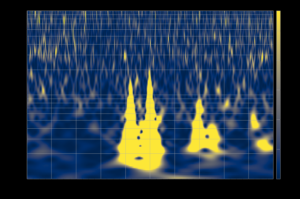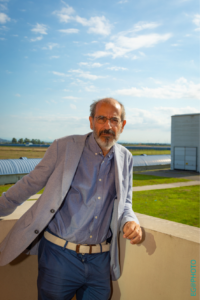
REINFORCE – Minimising the knowledge gap between science and society through Citizen Science
Interview with Stavros Katsanevas about the Citizen Science project REINFORCE
 The REINFORCE (Research Infrastructures FOR citizens in Europe) project aims to involve a broad public in the fascinating science of a Large Research Infrastructure. Through different citizen-science projects, REINFORCE aims to engage more than 100,000 citizens in making a genuine and valued contribution to managing the data avalanche. In this interview, we will learn more about the project from one of the project initiators, Stavros Katsanevas.
The REINFORCE (Research Infrastructures FOR citizens in Europe) project aims to involve a broad public in the fascinating science of a Large Research Infrastructure. Through different citizen-science projects, REINFORCE aims to engage more than 100,000 citizens in making a genuine and valued contribution to managing the data avalanche. In this interview, we will learn more about the project from one of the project initiators, Stavros Katsanevas.
REINFORCE is a project on Citizen Science, what do you think are the benefits of Citizen Science, both for the participants as well as for the scientists from the Research Infrastructures?
REINFORCE (https://reinforceeu.eu/) has, as a main goal, the involvement of citizens in frontier science, accompanying the gravitational-wave and multi-messenger scientific revolutions in their progress, while strengthening the corresponding links with particle-physics searches (e.g. Dark Matter). It also addresses environmental science, through the natural and synergistic embedding of astroparticle infrastructures in the geosphere and, more generally, the environment. Furthermore, the multi-messenger understanding of the cosmos naturally brings forward multi-sensorial analyses of the data (e.g. extension to sound and acoustics) bringing in turn, inclusion and diversity; extending participation to the visually impaired, confined and senior citizens. It should be clear here, that the increase of the sensorial means of apprehension of reality, e.g. the acoustics, is not only pursued as a means to increase the inclusion of the visually impaired, but it is also considered as a way to increase our perception capability, multiplying the ways we separate signal from background. The same border crossing also happens between the cognitive and the affective and REINFORCE thus addresses issues of art and science. Last, but not least, we hope that the engagement with scientific practice brings forward elements of critical thinking, an urgent task in these times of media inflation and digital connectivity.
In this effort, REINFORCE faces the challenge of trying, in an implementation as a two-way process, to: avoid the “instrumentalisation” of the citizen, using them as a classifying machine; effectively mix human and algorithmic methods (e.g. machine learning); help them to properly separate the correlational from the causal; avoid simplistic “illustration” in both multi-sensorial and art and science representation; accompany citizens in the process, through initiatives involving presence, hangouts and collectively, for both experts and citizens, enhance the effort to distinguish signal from background noise.
Which projects are part of REINFORCE? In addition, can you shortly explain the tasks the citizen scientist need to fulfil in these projects?
There are four projects, the gravitational-wave (GW) detector Virgo, at the European Gravitational Observatory, the high-energy neutrino-telescope, KM3Net, the ATLAS experiment at CERN and a muography project for geoscientific, archaeological and industrial infrastructure mapping. Regarding the specific tasks, let us start with Virgo. While the black-hole and neutron-star events detected follow specific General Relativity templates, used to identify the signal and also to extract the merger parameters, there are also transient events, “glitches” in the data, that are usually not related to astrophysical sources, but instead are caused by local disturbances, either technical or environmental, affecting the data quality and detection. So one of the tasks, for both GW experts and citizens, is to detect and classify glitches, that exhibit complex morphologies, to find their correlations and origin and remove them. A scientific discovery is not impossible, e.g. a supernova event would manifest itself as a glitch, and we have, from time to time, excitements of this sort. Machine Learning is also a promising tool to classify complex time-frequency patterns of glitches, and human input is required to train machine-learning models. An analogous task is performed in the KM3Net project, where citizen scientists help classify bioluminescence and bio-acoustic waveforms, forming the background for neutrino searches. In parallel, and changing point of view, these studies, address the issues of biodiversity of the deep sea. Pelagic and benthic bioluminescent organisms communicate through light. Cetaceans communicate through acoustic signalling, giving information on their sex, size and age. Here also, machine-learning algorithms can be of help. The two other projects concern tracking methods at the Atlas/LHC or cosmic rays, and the citizen scientist’s task is to go beyond the simple tracking algorithms, towards the identification of extra features, displaced vertices indices of new physics in LHC or extra hit signs of showering activity in the muography project. Here the citizens help to improve the search and reconstruction algorithms. In the muography case, again the relationship with environment, through the correlation of cosmic rays with nebulosity, atmospheric pressure etc. is an aspect of the task and can become a distributed activity around the schools of a region.
It is important to note here, that the above tasks profit from two important assets: a) the fact that they will be deployed in Zooniverse, currently the most visited citizen science platform in the world, whose initiator Chris Lintott and his group at Oxford University are partners in REINFORCE; b) the fact that data will be represented in both visual and acoustic forms, enhancing the classification and perception capabilities of both the expert scientists and the citizen scientists. In the second task, we are privileged to have the help of Wand Merced Diaz and Beatriz Garcia (of the sonoUno project) for the sonification of astronomical data. Wanda Merced Diaz, in particular, is a blind astronomer, who has for many years been leading a movement for the sonification of astronomical data, not only in the spirit of increasing inclusion, but also in the spirit of enhancing human perception potential. This last characteristic is special to the REINFORCE effort and distinguishes it for instance from the equally potent Gravity Spy project, authored by LIGO scientists, and which is already deployed in Zooniverse.

Sketch of the KM3NeT detector which is one of the large scale research infrastructures that join citizen science with the Deep Sea Hunters project. (Credits: KM3Net)
What events do you plan in the future?
We are currently finishing the beta version of our software, and we plan to have a full functioning environment for all four projects by the middle of 2021. The presentation of these citizen science environments will be inaugurated in summer 2021. Beyond the sprints and hangouts, that will necessarily accompany the participating citizens, we hope to also hold face-to-face meetings and we will continue to organise the series of workshops and “multiplying” events that have taken place this year and where the emphasis is on interactivity and feedback from the citizen scientists.
Furthermore, as I said above, for astroparticle physics, citizen science is naturally connected to a series of other themes: multi-messenger astrophysics, environmental and geoscience synergy, multi-sensorial development, art and science and critical thinking.
Regards multi-messenger physics, we are related to many other astroparticle physics efforts, that are also supported by other EU-funded projects (ESCAPE, ASTERICS) and, since our final deliverable is a roadmap for the field, we will try to coordinate with similar efforts towards this. APPEC is, of course, a perfect environment for this since the field has so many opportunities for exciting citizen science, through the plethora of open-data from gravitational waves to Vera Rubin/LSST maps. We will also organise, in the context of the EU-funded AHEAD2020 programme, workshops on multi-messenger physics, in 2021 and 2022; they will be an occasion to associate a citizen science element to the agenda.
This citizen-science roadmap should be in synergy with nearby science domains, particle and nuclear physics and astrophysics, eventually in the context of JENAS, but also, and in particular, geoscience and environment, with which we have been recently witnessing a convergence on many tools and concepts, from instrumentation to theory. This is even more so given that, in the first year of operation, we have been able to realise, through the many invitations we have received to present our programme (e.g. at the EU German Presidency event on Sustainable Development Goals through Citizen Science) that environmental and citizen-science themes will become a central framework, within which research and education opportunities will develop in the post-pandemic era.
A large number of activities will also be naturally centred on sonification. We are extremely happy that Wanda Merced Diaz will join the EGO staff in early 2021. Through her guidance, we are in contact with the UN Office for Outer Space Affairs (UNOOSA), as well as NASA and ESA experts on the sonification of astrophysical data. Furthermore, in the context of the sonification work, we have entered into contact with a series of “acousmatic” artists, and here also an art and science exhibition, along the spirit of “The Rhythm of Space”, which we organised in 2019, is under discussion. Last, but not least, we are in contact with Saul Perlmutter, whose “Big ideas Berkeley” critical-thinking course, “Sense and Sensibility in Science” has been an important inspiration for REINFORCE, in order to implement an equivalent European activity, using citizen-science data obtained above as first material.

Illustration of the so called glitches which should be recognized in the Gravitational Wave noise hunting project. (Credits: EGO)
It is statistically observed that the participation to Citizen Science activities decrease often exponentially. How do you think we can keep the citizen engaged and attract his/her long-term interest in activities?
We are lucky to have in REINFORCE, beyond the research actors (EGO, INFN (Italy), CNRS (France), University of Pisa (Italy), CONICET (Argentina), IASA (Greece)) a series of expert organisations, in education, engagement and citizen science (University of Oxford (UK), Open University (UK), Ellino-germaniki Agogi (Greece), ZSI – Center for Social Innovation (Austria), Lisbon Council for Economic Competitiveness and Social Renewal (Belgium), and the company Trust-IT) addressing the citizen-science engagement-strategy. This brings in parallel to the software development of the demonstrators, a large effort aimed at raising awareness and sustainability, in website building, webinars, communication material and social media.
In the context of this strategy definition, after an extensive study of bibliography and definition of criteria, a census (300 persons) was launched covering many countries and types of citizen scientist (from education to the general citizen) addressing key questions: Who are the potential citizen scientists that can be engaged in REINFORCE? How do we engage different target groups? Can we balance user inclusiveness and scientific productivity in the design and implementation of the REINFORCE demonstrators? What are the demonstrator design considerations to achieve such a balance? How can citizen motivation be sustained over time? What are the needs of different target groups? The first results of the survey show that a) respondents’ interest is high and that no significant changes are observed between demonstrators; b) motivations relevant to social standing and sharing with colleagues and social media do not seem as important as “helping to make discoveries” and “expecting to learn a lot about cutting edge science”; c) participants with prior experience in citizen science are (more) motivated by the opportunity to contribute to scientific research, by the opportunity to work with new data and feel more confident than the average to contribute in the project tasks; d) participants with strong scientific background display the same characteristics, with the addition that they “feel good to be involved in scientific research and are fascinated that they might make discoveries.”; e) “getting feedback”, “understanding the scientific impact of their work”, “receiving training” and using an “interface that is easy to manipulate” can be considered as the most important factors that can influence their sustained engagement. The results of the study are used to shape the project’s activities to design different, more targeted and appropriate engagement activities to successfully engage, train and retain them in the demonstrator project(s) for a longer period of time.
Do you also evaluate the impact of your Citizen Science projects?
Here we profit from the expert help of ZSI – the Center for Social Innovation (Austria), that has prepared a thorough plan, using state of the art methodology, based on a precise definition of inputs, outputs, outcomes and impact, to elaborate an impact-assessment strategy, including questionnaires, but also self-assessment, live interaction, pre- and post-involvement.
I would like to close on a series of more general thoughts. It is clear that after COVID-19 we are entering a new era, where communication and digital connectivity is becoming the definition of our social space-time, while in parallel Earthly and biological space-time-matter are at a critical point. We have also seen in the past months, examples of political/societal life around the world becoming more and more dependent on publicity-inspired mass-persuasion techniques, developing ambiguous relations to science and critical thinking. In parallel, researchers and teachers themselves suddenly became an ambiguous centre of attention. The content of academic research and education has also come under discussion. On the positive side, the pandemic brought teachers, digitally, in to the home. Families started to realise their role, the work of high-school teachers started to be recognised, breaking the ideologically dangerous “vendor-client” model of education. We academics should also admit that, in recent years, research and education have followed separate paths of specialisation, that have undoubtedly given great advances in science and technology, but also a sense of isolation to enthusiastic teachers attempting to communicate science in schools.
Once more, the proper embedding of humanity in the cosmos is in question, where the ancient notion of cosmos covers, as in antiquity, not only the Universe, but also the geosphere, society and the internal cosmos. A new synthesis of Research and Education, in the most general sense, is needed. I think that we are not alone in realising this. These facts were also remarked upon by the very inspiring article by Kip Thorne and Roger Blandford on “Post-pandemic science and education”, (https://aapt.scitation.org/doi/full/10.1119/10.0001390) where they even formulated a general call: “we scientists must now begin to think seriously about rebuilding our nation and society in the post-Covid era.“
In conclusion, there is plenty of interesting work in the citizen-science field for APPEC and for our newly-elected chair, Andreas Haungs, and General Secretary, Katarina Henjes-Kunst, to whom I seize the opportunity to wish a rich and productive mandate.
Further information
- REINFORCE: https://reinforceeu.eu/
- Zooniverse: https://www.zooniverse.org/
- EU-Citizen Science website: https://eu-citizen.science/

Stavros Katsanevas (Credits: EGO)
Stavros Katsanevas, currently Director of the European Gravitational Observatory (since 2018) and professor exceptional class at University of Paris, was born in 1953 in Athens. He has been assistant professor and professor at the Universities of Athens and Lyon, as well as CERN fellow and associate. He has worked in experiments on QCD, e+e-, supersymmetry and neutrinos at Fermilab (E537), CERN (ISR,PS180,DELPHI,OPERA) and the NESTOR high energy neutrino observatory. He has served as deputy director of the National Institute of Particle and Nuclear Physics (IN2P3) of CNRS (2002-2012); coordinator of the first ASPERA EU funded network of Astroparticle Physics (2006-2009); first chairman of APPEC (2012-2014); director of the Laboratory of Astroparticle Physics and Cosmology (APC) of IN2P3/CNRS-Paris Diderot-CEA-Observatoire de Paris (2014-2017) and co-director of the Astrophysics-Geophysics Laboratory of Excellence UnivEarths. He has also served as chair and co-chair of the European Gravitational Observatory Council (2002-2012); and chair of the Finance Board of the Auger Observatory (2011-2014).




